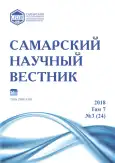Экологический мониторинг ерика Судомойка Волго-Ахтубинской поймы
- Авторы: Герман Н.В.1, Бабичева А.В.1, Манаенков И.В.1, Севрюкова Г.А.2
-
Учреждения:
- Волгоградский государственный университет
- Волгоградский государственный технический университет
- Выпуск: Том 7, № 3 (2018)
- Страницы: 27-31
- Раздел: 03.02.00 – общая биология
- URL: https://journals.rcsi.science/2309-4370/article/view/21682
- DOI: https://doi.org/10.17816/snv201873105
- ID: 21682
Цитировать
Полный текст
Аннотация
Работа посвящена экологическому мониторингу и системному анализу водоема Волгоградской области (ерик Судомойка). Экологический мониторинг проводился с марта 2017 года по февраль 2018 года. В комплекс исследований входило: определение органолептических показателей воды, количества растворенного кислорода в водоеме, водородного показателя, сухого остатка и биоиндикация. Установлено увеличение количества микроорганизмов: синедры (Synedra), спирогиры (Spirogyra), мужоции (Mougeotia), которые являются биоиндикаторами качества воды, – в июле, сентябре 2017 г. и в феврале 2018 г. Наличие высокого количества микроорганизмов-биоиндикаторов свидетельствует о перенасыщении воды кислородом и образовании органических веществ. Выявлено повышение минерализации воды в марте, июле, декабре 2017 г., феврале 2018 г. В пробах воды ерика Судомойка в зимний период обнаружено большое количество слизи, яйцекладок различных насекомых, органической грязи, что свидетельствует о загрязнении водоема в зимний период. Качество воды в ерике Судомойка неудовлетворительное, ерик классифицируется как слабозагрязненный водоем. Ерик Судомойка не может быть использован в бытовых целях жителями близлежащих населенных пунктов и является неблагоприятным для купания в летний период. Экологическое состояние ерика Судомойки обусловливает экологическое состояние всего природного комплекса Волго-Ахтубинской поймы.
Полный текст
Открыть статью на сайте журналаОб авторах
Надежда Валерьевна Герман
Волгоградский государственный университет
Email: nadya-grman@rambler.ru
кандидат биологических наук, доцент кафедры экологии и природопользования
Россия, ВолгоградАлина Валентиновна Бабичева
Волгоградский государственный университет
Email: sevrykova2012@yandex.ru
студент института естественных наук
Россия, ВолгоградИгорь Викторович Манаенков
Волгоградский государственный университет
Email: mana69@mail.ru
кандидат биологических наук, доцент кафедры экологии и природопользования
Россия, ВолгоградГалина Александровна Севрюкова
Волгоградский государственный технический университет
Автор, ответственный за переписку.
Email: sevrykova2012@yandex.ru
доктор биологических наук, доцент, профессор кафедры промышленной экологии и безопасности жизнедеятельности
Россия, ВолгоградСписок литературы
- Вершинина С.А., Маковкина Л.Н. Водные объекты Волго-Ахтубинской поймы // Грани познания. 2015. № 4 (38). С. 20-24.
- Брызгалина Е.С., Филиппов О.В., Кочеткова А.И., Баранова М.С. Экологическая оценка состояния водных объектов Волго-Ахтубинской поймы в условиях зимнего периода 2014-2015 гг. // Грани познания. 2015. № 4 (38). С. 104-113.
- Онищенко Г.Г. Состояние питьевого водоснабжения в Российской Федерации: проблемы и пути решения // Гигиена и санитария. 2007. № 1. С. 10-13.
- Коломин Ю.М. Экологический мониторинг состояния водоемов Северо-Казахстанской области и использование их биоресурсов // Экологический мониторинг и биоразнообразие: сб. материалов IV междунар. науч.-практ. конф. Ишим, 2012. С. 110-113.
- Жумадилова Ж.Ш., Сапаргалиева Г.М., Изимбет А.П. и др. Культивирование микроводоросли с целью получения биомассы в лабораторных условиях // Международный журнал прикладных и фундаментальных исследований. 2015. № 10-5. С. 838-839.
- Алешня В.В., Журавлев П.В., Головина С.В. и др. Значение индикаторных микроорганизмов при оценке микробного риска в возникновении эпидемической опасности при питьевом водопользовании // Гигиена и санитария. 2008. № 2. С. 23-27.
- Леванова Г.Ф., Мазепа В.Н., Кашников С.Ю. Экспресс-метод биотестирования воды в полевых условиях // Гигиена и санитария. 2004. № 1. С. 64-66.
- Бойцов А.Г., Ластовка О.Н., Кашкарова Г.П., Благова О.Е. Оценка качества воды по биологическим показателям: пути совершенствования // Гигиена и санитария. 2005. № 1. С. 74-77.
- Базилевич Н.И., Родин Л.Е. Географические закономерности продуктивности и круговорота химических элементов в основных типах растительности Земли // Общие теоретические проблемы биологической продуктивности. Л.: Наука, 1969. С. 24-33.
- Будаговский А.И. Ресурсы почвенных вод и водообеспеченность растительного покрова // Водные ресурсы. 1985. № 4. С. 3-13.
- Петров Б.И., Денисова С.А., Леснов А.Е. Фазовые равновесия и распределение элементов в системах вода - антипирин - органическая кислота // Известия Алт. гос. ун-та. 2003. № 3 (29). С. 230-236.
- Курамшина Н.Г., Курамшин Э.М., Лапиков В.В. Комплексный экологический мониторинг водных экосистем в условиях техногенеза // Экологические системы и приборы. 2004. № 8. С. 9-11.
- Алешня В.В., Журавлев П.В., Головина С.В. и др. Значение индикаторных микроорганизмов при оценке микробного риска в возникновении эпидемической опасности при питьевом водопользовании // Гигиена и санитария. 2008. № 2. С. 23-27.
- Позин С.Г. О некоторых подходах к запрету купания в водоемах по результатам микробиологического анализа воды // Медицинские новости. 2005. № 9. С. 69-70.
- Рахманин Ю.А. Приоритетные направления и критерии оценки загрязнения окружающей среды // Гигиена и санитария. 2003. № 6. С. 14-16.
Дополнительные файлы







